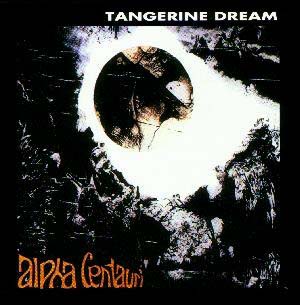In 1971 Tangerine Dream, the German pioneers of electronic music released their second album Alpha Centauri. The music on this album is quite different from TD's first album Electronic Meditation (1970). It contains more keyboards and electronic technology, although they mostly remain in the background. The dominant instruments on Alpha Centauri are the organ and the flute. This shift in instrumentation resulted in a style that band leader Edgar Froese described as' Kosmische Musik'. The album sold twenty thousand copies in Germany, nearly four times as much as their later classic album Phaedra (1974). Lately the album got a proper reissue, so I'll give you some historical facts first before I go a bit further into the music on the album. Klaus Schulze, one of the founding members of TD had already quit before the debut album was even released. He was frustrated by the musical limitations Edgar Froese was putting upon him. Founding member Conrad Schnitzler also quit so Froese was the only founding member left, before the recordings for the second album had even started. Chris Franke, a seventeen-year old drummer and co-founder of Agitation Free, joined the band first. Shortly afterwards organist Steve Schroeder would also join the new line-up. Although these line-up changes were significant, the undoubtedly most important change was the appearance of the VCS3-synthesizer. The use of this synthesizer on Alpha Centauri isn't yet as dominant as it would be on future releases, since its prime function was to provide for strange and fascinating new sounds. In terms of musical content, Froese quickly guided TD away from the intense experiments on the debut album to the atmospheric ambience which would become their trademark. The original LP contains just three tracks and has a total playing time of almost forty minutes. The shortest track Sunrise In The Third System opens the album. This four-minute piece contains slow moving organ over spacey sounds and effects. At the time of its release, it would perhaps have sound far more revolutionary than it does now, although it has a clear nod to Pink Floyd thanks to the sound of the organ. The thirteen-minute Fly And Collision Of Comas Sola was the other track on side one of the original LP. This one featured interesting organ sounds and some flute playing by one Udo Dennenbourg. The synthesizers are once again used for effects rather than lead instruments. As the track builds towards its conclusion, we have something that must be the earliest example of post rock with some very dominant drum parts. In this track a theme has been included that would be extracted for the rare single Ultima Thule. The centre piece of the album is the 22-minute title track that covered side two of the LP. It has some lazy, ambient sounds performed on the organ and synthesizers. At the same time this track is an incredible spacey and timeless experience starting with calm but strange electronic sounds and exotic flute variations, than progressively continuing into an amazing sound universe. You got the impression of leaving the world you're in. The sinister, haunted and lamented voices at the end of the tune close this adventure. On Alpha Centauri TD continues to experiment with sounds, moods and styles. At the same time you definitely hear influences of Pink Floyd's psychedelic period throughout the album. The new remastered version has three bonus tracks. Ozillator Planet Concert is an eight-minute long live track recorded in Austria, June 1971. So far it was only available on a live double album recorded in 1971 with the title Ossiach Live. On this piece you'll hear the same kind of ambient sounds performed on an organ and a VCS3-synthesizer. Sometimes it seems as if you're listening to a concert performed by a singing saw, but also the Pink Floyd influences are noticeable thanks to the guitar and organ effects. The second and third bonus track are Ultima Thule, part 1 and Ultima Thule, part 2 both released as a single in 1971. Nowadays it's an extremely rare single. The A-side makes use of the same, rather aggressive and up-tempo guitar riff as F ly And Collision Of Comas Sola, one of the regular tracks of the album. The B-side starts rather mellow and has some nice Mellotron parts. After a couple of minutes the tempo increases. The A-side is very similar to the musical direction of TD's first album; the B-side already contains traces of the later sound. The single never made it to the charts, because it was a private release at the time. It's always difficult to judge an album that was originally recorded in 1971. Do you have to judge it by taking the technical limitations into account or give a rating according to the present-day knowledge? The latter option suited me best because we always listen to music at present and not in the past. In my humble opinion Alpha Centauri isn't a bad TD-album, but I guess I won't play it that often, so as a consequence it won't get a high rating, although the album made history in the music scene. **+ Henri Strik (edited by Peter Willemsen) Where to buy? |
